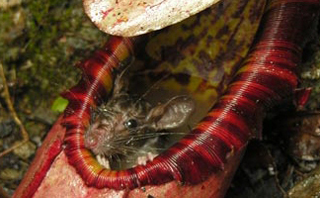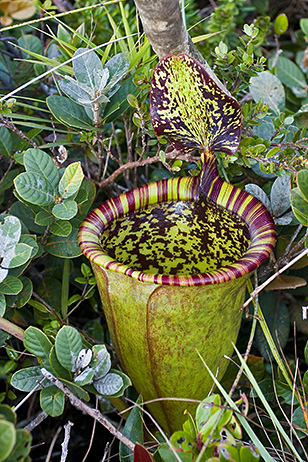Human Flower Project
Rat Traps of Mount Victoria
This carnivorous plant from the Philippines tugs the old chain of being in a surprising direction.

A rat lured into the “slipper like mouth” of a pitcher plant
Photo: Stewart McPherson
We’ve known that some plants are rodent pollinated. Now we learn of one that’s rodent satiated.
Nepenthes attenboroughii, a pitcher plant of Palawan Island in the Philippines, has the scale and gastric juices to digest rats. After hearing of such large carnivorous plants from “Christian missionaries,” a team of botanists began the search. They came upon this mouse-trap, with pitchers big enough to hold 1.5 litres, in the region of Mount Victoria two years ago and recently published their findings in the Botanical Journal of the Linnean Society.
 Nepenthes attenboroughii, carnivore of Palawan Island, The Phillippines
Nepenthes attenboroughii, carnivore of Palawan Island, The Phillippines
Photo: Dr. Alastair Robinson, via wiki
“The (plant’s) victim drowns in the pitcher, and acids and enzymes in the fluid within the trap break down the remains of the prey,” Stewart McPherson explained, adding “only the bones remain.”
How does that work out? Is Nepenthes attenboroughii a prolific belcher, too?
The botanists chose to name their discovery after naturalist and BBC broadcaster Sir David Attenborough.
Sir David, 83, said: “I was contacted by the team shortly after the discovery and they asked if they could name it after me. I was delighted….”
Quite a grisly honor, even for a knight.
Comments
Dear Margaret,
I think we need to contact the researchers on this one… Will try to get an address for the team and get on it.
Let’s get back to Teo’s soon!
J.
Dear Margaret and All,
Alastair Robinson of the botanical research team that found and has been studying this pitcher plant in the Philippines kindly sent the following:
Dear Julie,
Many thanks for your message, and for your interest in this taxon. The majority of rodent bones in Nepenthes remain more or less intact, settling at the bottom of the pitcher in time. This is because pitcher fluid simply isn’t potent enough to break down bone in the lifetime of the pitcher, an average pitcher usually lasting just a few weeks to a couple of months depending on the species.
The pitchers are simply extensions to the leaves, and as the plant grows, old leaves and pitchers wither; any pitcher contents simply remain in the dried husk of the pitcher until decomposition of the dead pitcher ruptures the pitcher walls.
I must clarify that while Nepenthes attenboroughii is large enough to trap them, no rodents have yet been found inside its traps; they have been found in pitchers of other species, but claims that this species is rat-devouring are merely the result of sensational misrepresentation by the popular press. I suppose it makes a good story, but it is a shame considering how remarkable the plant is even in the absence of such hyperbole!
Best wishes,
Alastair
Dear Julie,
What an amazing post!
Lol, the mouse looks innocent tho’…
Surely only a great knight like Sir David Attenborough is able to cherish such honour however grisly it may be…
Best wishes,
Sandy Ao
Julie, this is amazing. I posted the link in Flower Chat; hope you don’t mind…
Many thanks to you, goldfish!
Amazing post. Would this be considered a “humane” rat trap?


amazing!
what does happen to the bones?